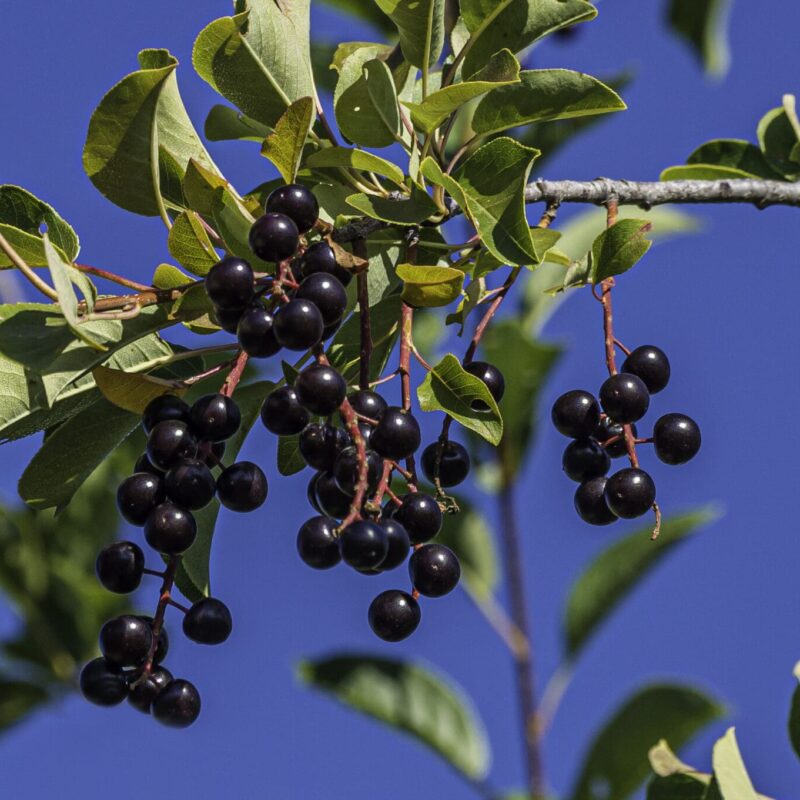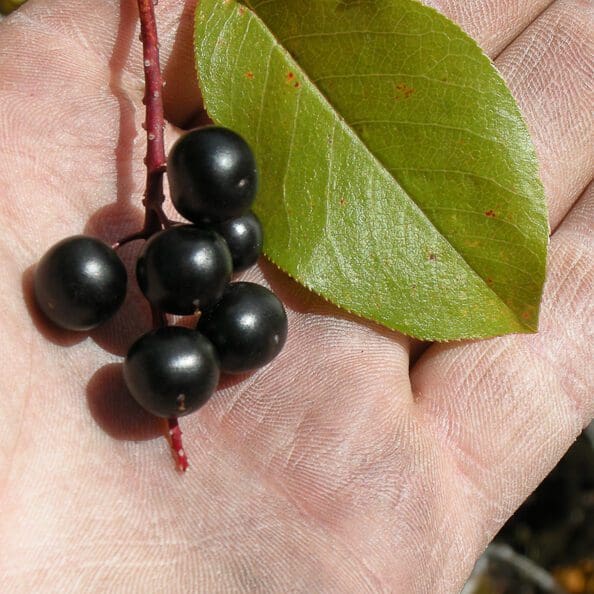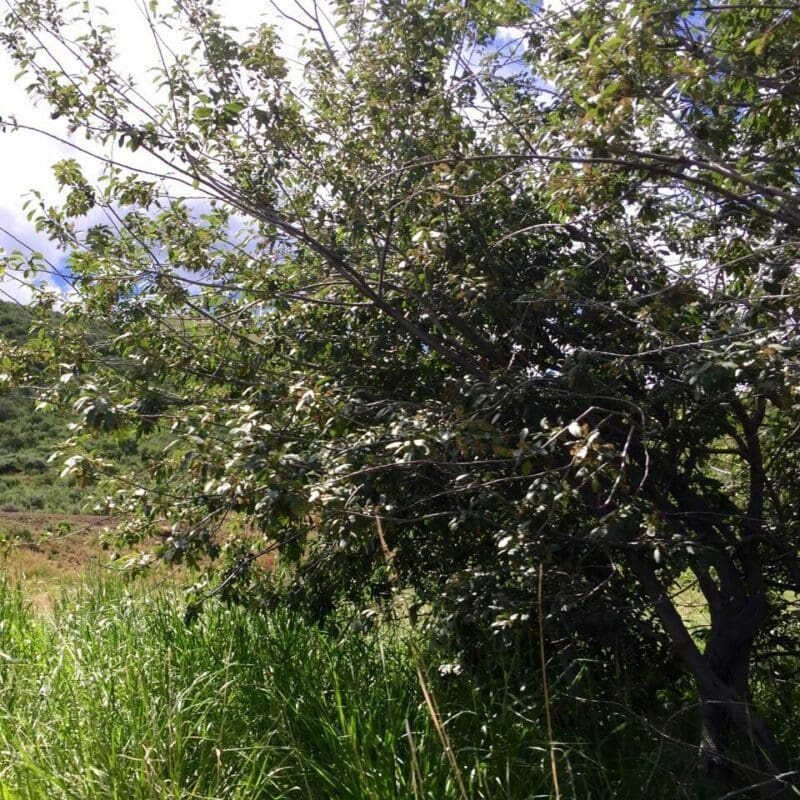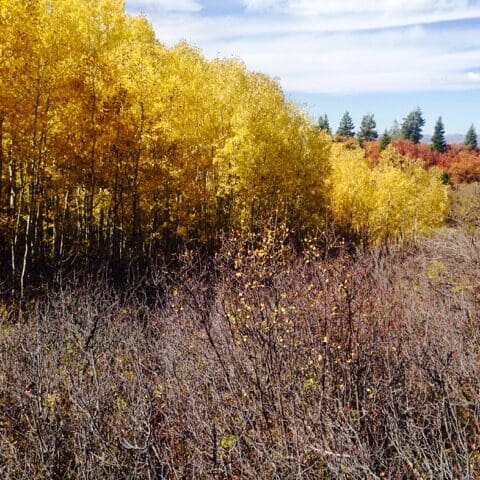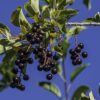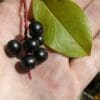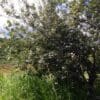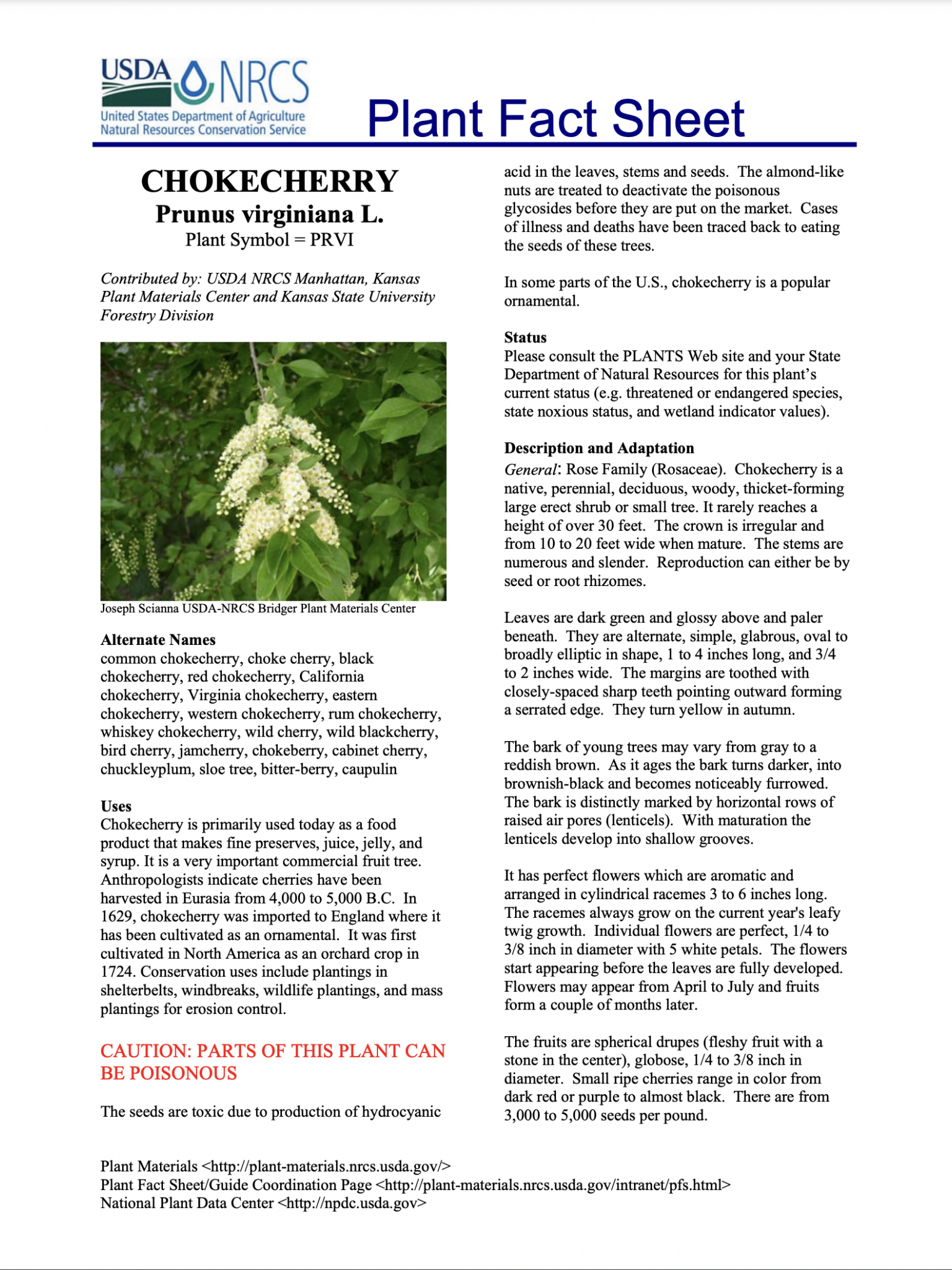Chokecherry
- Scientific name: Prunus virginiana
- Usually occurs in dense thickets or large clusters
- Can be pruned as a single-trunk ornamental
- Common ornamental with fragrant blossoms
- Can be pruned for fruit bearing applications
- Common in canyon bottoms and northern aspects
- Good erosion control plant
- Important to many wildlife animals
103 in stock
Chokecherry (Prunus virginiana) is a native, perennial, deciduous, woody, erect shrub or small tree. In its native habitat it almost always occurs in dense thickets or large clusters. It can, however, be pruned as a single-trunk ornamental in landscaping or fruit bearing applications. It rarely reaches a height of over 30 feet. It occurs most commonly in canyon bottoms and northern aspects at 6-8’000 feet. It can occur as low as 5,000 feet. Can be transplanted and adapted to yards. When pruned it can be shaped into tree form, but it naturally occurs as shrubby, densely formed stands. Well adapted to riparian zones.
Chokecherry (Prunus virginiana) is used extensively in shelterbelts, windbreaks, wildlife habitat and mass plantings for erosion control. It does well in riparian areas. It provides thermal cover for wildlife. It works well in stabilizing streambanks. It is used on disturbed sites such as mined land reclamation, highway right-of-ways and construction sites. It is a good erosion control plant because it forms thickets and spread by rhizomes. Chokecherry is well adapted to fire disturbance. It can be top-killed by fire, but re-sprouts readily from root crowns and rhizomes.
Chokecherry is important to many wildlife animals. Birds, rabbits, hares, rodents and bears all seek out and eat its fruit. It provides food, cover and nesting habitat for a variety of birds. Birds also take advantage of its growth form for cover and nesting habitat. It is used extensively by deer as a browse source in the winter. The early spring very aromatic flowers are an important source of nectar for butterflies, honeybees and ants.
In some parts of the U.S., chokecherry is a popular ornamental. Its quick growth, mature size, attractive white flowers in the spring and strong, sweet and almond-like aroma fragrance make it a good yard tree in urban neighborhoods. Cultivars are planted for ornamentals rather than the native species. All native chokecherry varieties have a great tendency to sucker, which can create problems in lawn care. Most cultivated varieties do not have this suckering trait while producing more attractive flowers and/or larger fruit. The fruit also attracts a diverse population of birds for a number of weeks. Chokecherries can be a component in a screen or noise barrier planting.
The common name, chokecherry, came from the bitter and astringent taste of the fruit. Pioneers and settlers came to realize its food value. Mature fruits are still collected today and used to make jellies, jams, pie-fillings, syrups, sauces and wines.
The leaves, bark, stem, and stone (seed pit) of chokecherry are all toxic. It is potentially poisonous to all classes of livestock, but cattle and sheep are the ones commonly affected. The meaty flesh of the fruit is not toxic. There have been reported human deaths, usually of children chewing on the stems and leaves, or swallowing the stones.
For other variety options: Shrubs
***Click on “Quick Plant Facts” tab above for more information
Chokecherry NRCS Plant Fact Sheet
Chokecherry NRCS Plant Fact Sheet
PDF version of NRCS Plant Guide & Fact Sheet
Prepared By: Wayne A. Geyer, Forestry Division, Kansas State Research and Extension, Kansas State University, Manhattan, Kansas
Patrick J. Broyles, Formerly USDA NRCS Manhattan Plant Materials Center, Manhattan, KS
John M. Row, USDA NRCS Manhattan Plant Materials Center, Manhattan, KS
Species Coordinator: Patrick J. Broyles, Formerly USDA NRCS Manhattan Plant Materials Center, Manhattan, KS
Helpful Links
Additional information about this product can be found on the academic websites linked below.
Synonyms
Many plants have more than one common and scientific name. We've listed a few of them below.
- Chokecherry
- Prunus virginiana
- Bitter-Berry
- Virginia Bird Cherry
- Western Chokecherry
Who is Great Basin Seed?
Great Basin Seed is a seed company that specializes in seed sales and consultation for home, ranch, farm, range and reclamation. We have been a leader in the seed industry since 1974.
Our History
We've been in the seed business since 1974.
What We Offer
We offer seed for home, farm, ranch, range and reclamation projects.
Meet the Gang
We have the best employees in the world! We are proud of the work they do, and trust them to serve you!
Right: Company founder Lloyd and his wife Paula Stevens in a wildflower seed production field circa 1977
Quick Plant Facts
| Common Name: | Bitter-Cherry, Virginia Bird Cherry |
|---|---|
| Scientific Name: | |
| Lifespan: | |
| Origin: | |
| Plant Type: | |
| pH Tolerance: | |
| Seed Count | 4800 |
| Growth Height: | |
| Min. Precipitation | 14 Inches Minimum |
| Best Time to Sow: | |
| Max Sowing Depth: | |
| Growth Season: | |
| Sun & Shade Tolerance: | Low Shade Tolerance, Full Sun |
| Zone Map | comingsoon.gif |
| Plant PDF File | prvi.pdf |
| Hardiness Zones: |
